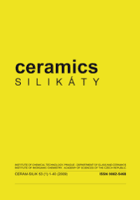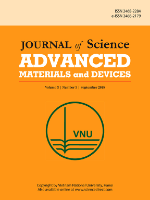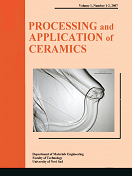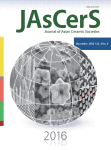
Journal of the Korean Ceramic Society
Scope & Guideline
Exploring the art and science of ceramics and composites.
Introduction
Aims and Scopes
- Ceramic Material Synthesis and Characterization:
Research on the synthesis techniques and characterization methods for various ceramic materials, including traditional and advanced ceramics, is a core focus. This includes studies on the effects of different processing conditions on the microstructure and properties of ceramics. - Functional Properties of Ceramics:
Investigations into the electrical, thermal, mechanical, and optical properties of ceramics are central to the journal. This encompasses studies on dielectric, piezoelectric, magnetic, and thermoelectric properties, which are critical for various applications. - Innovative Applications of Ceramics:
The journal explores innovative applications of ceramics in fields such as electronics, energy storage, catalysis, and biomedical devices. Research on the integration of ceramics in these areas is emphasized, showcasing their multifunctionality. - Nanostructured and Composite Ceramics:
There is a significant focus on the development of nanostructured ceramics and ceramic composites, which enhance performance through improved mechanical, electrical, and thermal properties. This includes studies on the incorporation of nanoparticles and the development of hybrid materials. - Environmental and Sustainable Ceramics:
Research that addresses environmental concerns, such as the synthesis of eco-friendly ceramics and the recycling of ceramic materials, is increasingly important, reflecting a commitment to sustainability in materials science. - Computational and Theoretical Studies:
The journal also includes computational studies that model and predict the behavior of ceramic materials, utilizing methods such as density functional theory (DFT) and Monte Carlo simulations to gain insights into material properties at the atomic level.
Trending and Emerging
- Energy Storage and Conversion:
There is a growing emphasis on the development of ceramic materials for energy storage and conversion applications, including solid oxide fuel cells, supercapacitors, and batteries. This trend is driven by the demand for sustainable energy solutions. - Advanced Functional Ceramics:
The emergence of advanced functional ceramics, such as piezoelectric, thermoelectric, and magnetic ceramics, is prominent. Researchers are focusing on enhancing the performance of these materials for applications in sensors, actuators, and electronic devices. - Bioceramics and Biomedical Applications:
Research on bioceramics for medical applications, particularly in bone regeneration and drug delivery systems, is gaining traction. This reflects an increasing interest in the intersection of materials science and healthcare. - Nanotechnology in Ceramics:
The integration of nanotechnology in the development of ceramic materials is a significant trend. Researchers are exploring the unique properties of nanostructured ceramics and composites to enhance performance and functionality. - Sustainability and Environmental Impact:
Emerging themes related to the sustainability of ceramic materials, including their lifecycle assessment, recycling, and eco-friendly synthesis methods, are becoming increasingly relevant in the context of global environmental concerns. - Computational Materials Science:
The use of computational methods for the design and optimization of ceramic materials is on the rise. This includes simulations and modeling to predict material behavior, which complements experimental approaches.
Declining or Waning
- Traditional Ceramics:
Research on traditional ceramics, such as porcelain and stoneware, appears to be declining in favor of advanced materials and applications. The focus has shifted towards innovative materials that offer enhanced functionalities. - Basic Sintering Studies:
Studies that primarily address basic sintering processes without a clear application or advanced characterization are becoming less prominent. Researchers are increasingly integrating sintering studies with applications in energy storage, catalysis, or other functional areas. - Single-Component Ceramics:
The trend is moving away from studies focused solely on single-component ceramics towards more complex systems, including composites and hybrid materials that leverage the benefits of multiple components. - Conventional Characterization Techniques:
There is a noticeable decline in the publication of studies that utilize traditional characterization techniques without incorporating advanced methods or innovative approaches, as researchers are seeking more comprehensive analyses.
Similar Journals

CERAMICS-SILIKATY
Exploring the Boundaries of Ceramics ResearchCERAMICS-SILIKATY is a distinguished open-access journal published by the University of Chemistry and Technology, Prague, specializing in the fields of Ceramics and Composites, Analytical Chemistry, Chemical Engineering, and Materials Chemistry. Since its inception in 1991, this journal has played a pivotal role in disseminating cutting-edge research and innovative findings in the study of ceramics, emphasizing both fundamental and applied aspects. With a commitment to accessibility since 2000, CERAMICS-SILIKATY promotes knowledge sharing among researchers, professionals, and students globally. The journal's current standing in the Q3 Quartile across several categories highlights its significant contributions and relevance in the academic community. As a hub for interdisciplinary research, the journal invites submissions that advanced our understanding of ceramic materials and their applications, positioning itself as an essential resource for those engaged in the forefront of materials science.

REFRACTORIES AND INDUSTRIAL CERAMICS
Bridging Theory and Application in Ceramics ResearchREFRACTORIES AND INDUSTRIAL CERAMICS is a prestigious journal published by Springer, dedicated to the field of ceramics and composite materials. With an ISSN of 1083-4877 and an E-ISSN of 1573-9139, this journal plays a pivotal role in fostering advances in the development, formulation, and application of refractories and industrial ceramics. The journal has been actively publishing since 1996 and is recognized for its contribution to the academic discourse in the ceramics community. Although it currently holds a Q4 ranking in both Ceramics and Composites and Materials Chemistry categories, it serves as an important platform for emerging research trends and innovations, making it essential reading for researchers, professionals, and students engaged in material science. While access is not open, the journal ensures that high-quality research reaches its audience, reflects the evolving landscape of the ceramics industry, and encourages interdisciplinary collaboration.

JOURNAL OF SOL-GEL SCIENCE AND TECHNOLOGY
Connecting Academics and Industry for BreakthroughsJOURNAL OF SOL-GEL SCIENCE AND TECHNOLOGY, published by Springer, is a vital resource within the interdisciplinary fields of materials science and engineering, focusing on innovative research related to sol-gel processes and applications. With a rich publication history spanning from 1993, this journal enables the dissemination of cutting-edge findings in biomaterials, ceramics, and composites, ranking impressively across various categories—Q3 in Biomaterials and Q2 in several other materials-related fields. The journal's commitment to quality research is reflected in its Scopus rankings, particularly notable in the categories of Condensed Matter Physics and Materials Chemistry. Researchers and professionals leveraging the insights from this journal are supported through its comprehensive scope, which bridges theoretical foundations with practical applications, advancing knowledge and fostering collaboration among academics and industry leaders alike. As a non-open access journal, it is essential for subscribers and institutions to engage deeply with the latest advancements documented within its pages, underscoring the journal's role in shaping the future of sol-gel science and technology.

JOURNAL OF INORGANIC MATERIALS
Elevating Knowledge in Inorganic MaterialsJOURNAL OF INORGANIC MATERIALS, published by SCIENCE PRESS, is a prominent platform dedicated to the dissemination of research in the fields of inorganic chemistry and materials science. With a history spanning over three decades since its inception in 1993, this journal has become a key resource for academics and industry professionals alike, aiming to advance the understanding of inorganic materials through rigorous research findings. It operates under a strict peer-review process, ensuring high-quality contributions that uphold its reputation within the scientific community. Currently ranking in the Q3 category for both inorganic chemistry and miscellaneous materials science, the journal holds a significant position in Scopus rankings, further solidifying its relevance and impact. Researchers will find this journal an essential avenue for the latest discoveries and methodologies in inorganic materials, fostering innovation and collaboration in a vital area of science.

Journal of Science-Advanced Materials and Devices
Unleashing Potential: Where Science Meets InnovationJournal of Science-Advanced Materials and Devices is a leading open-access journal published by Vietnam National University, dedicated to advancing the field of materials science through cutting-edge research and innovative developments. Since its inception in 2016, this journal has become a pivotal platform for sharing insights and discoveries in various subfields, including biomaterials, ceramics and composites, and electronic, optical, and magnetic materials. With impressive quartile rankings, including Q1 across multiple categories in 2023, and a notable Scopus ranking placing it in the top 15th percentile for ceramics and composites, it highlights the journal’s influence and prestige within the global academic community. Open Access since its launch, the journal aims to facilitate unrestricted dissemination of scholarly work, empowering researchers, professionals, and students to engage with the latest advancements. The Journal of Science-Advanced Materials and Devices is vital for those seeking high-quality contributions that influence both theoretical understanding and practical applications in the ever-evolving landscape of materials science.

Journal of Advanced Dielectrics
Advancing the Frontiers of Dielectric ResearchThe Journal of Advanced Dielectrics, published by World Scientific Publishing Co Pte Ltd, is a pivotal open-access platform since 2014 dedicated to advancing research in the fields of dielectrics, ceramics, and composites. Based in Singapore, this journal aims to bridge the gap between theoretical developments and practical applications in Electrical and Electronic Engineering, Condensed Matter Physics, and Electronic, Optical, and Magnetic Materials. With an impressive classification in the 2023 Quartile Rankings indicating its significance within its categories, and notable Scopus Rankings that highlight its impact and relevance, this journal serves as a vital resource for scholars and professionals committed to cutting-edge research and innovation. As it continues to flourish through the converging years from 2015 to 2024, the Journal of Advanced Dielectrics stands as an essential conduit for the dissemination of knowledge in advanced material sciences, making it an indispensable asset for today's research community.

GLASS AND CERAMICS
Exploring the Boundaries of Glass and Ceramics ResearchGLASS AND CERAMICS is a premier academic journal published by Springer, focusing on the vital fields of ceramics and composites, materials chemistry, and the mechanics of materials. Since its inception in 1956, this journal has contributed significantly to the advancement of knowledge and innovation in these domains, with a commendable 2023 Q3 quartile ranking in its categories. With an ISSN of 0361-7610 and an E-ISSN of 1573-8515, GLASS AND CERAMICS provides a platform for rigorous research and scholarly discussion, catering to a diverse audience of researchers, professionals, and students. Although the journal does not currently offer open access, it continues to disseminate vital insights that drive advancements in the materials science community. The journal’s commitment to high-quality research is underscored by its long-standing publication history and relevance in shaping future materials technology.

JOURNAL OF ELECTROCERAMICS
Pioneering Research in Electroceramics and BeyondJOURNAL OF ELECTROCERAMICS, published by SPRINGER in the Netherlands, serves as a pivotal platform for advancing the field of electroceramics since its inception in 1997. With a keen focus on innovative materials and applications, this journal covers diverse areas encompassing ceramics and composites, condensed matter physics, and electronic materials, significantly contributing to interdisciplinary research. Although currently not an Open Access publication, the journal's engagement in rigorous peer review ensures the dissemination of high-quality research, supported by its respectable Q3 ranking in several relevant categories in 2023. Researchers and professionals will find value in its comprehensive scope, showcasing cutting-edge developments that shape the future of engineering and materials science. The JOURNAL OF ELECTROCERAMICS continues to play a crucial role in bridging theoretical discoveries with practical applications, making it an indispensable resource for students, scholars, and industry experts alike.

Processing and Application of Ceramics
Shaping the Future of Ceramics and CompositesProcessing and Application of Ceramics is a prominent open-access journal dedicated to the advancement of knowledge in the field of ceramics and composites. Published by the University of Novi Sad, Faculty of Technology in Serbia, this journal has been fostering research and innovation since its inception in 2007. With its ISSN 1820-6131 and E-ISSN 2406-1034, this journal is indexed in Scopus, where it holds a ranking of #82 out of 127 in the Materials Science category, placing it in the 35th percentile and within the Q3 quartile as of 2023. Spanning a convergence period from 2014 to 2024, the journal serves as a vital platform for researchers, professionals, and students alike, eager to explore the latest developments in ceramic materials, their processing techniques, and practical applications. The journal's commitment to accessibility and quality makes it an essential resource for those aiming to stay at the forefront of ceramics research.

Journal of Asian Ceramic Societies
Unlocking the potential of ceramic science.The Journal of Asian Ceramic Societies, published by Taylor & Francis Ltd, is a peer-reviewed open-access journal that has been at the forefront of ceramic research since its inception in 2013. With an ISSN of 2187-0764, this esteemed journal is dedicated to advancing the scientific understanding of ceramics and composites, bolstered by an impressive ranking of Q2 in the field of Materials Science. Covering a wide range of topics pertinent to ceramics, the journal aims to foster collaboration among researchers, professionals, and students across Asia and beyond. Its commitment to accessibility allows a global audience to engage with cutting-edge research, reflected in its Scopus ranking of #45 out of 127 in the Materials Science category. With a publication timeline extending to 2024, the Journal of Asian Ceramic Societies is an indispensable resource for anyone looking to stay informed on the latest developments and innovations in ceramic technology.